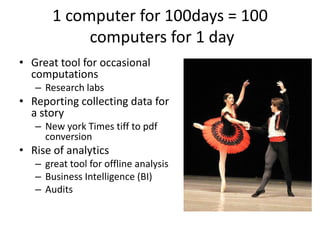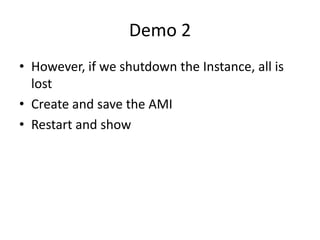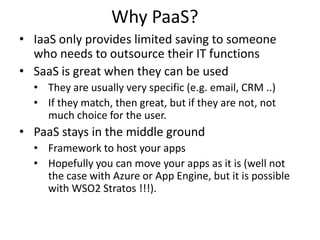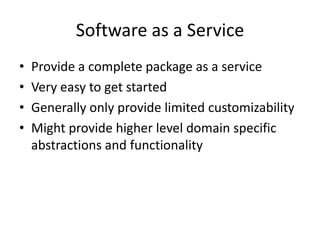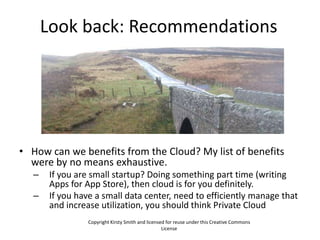IEEE Cloud 2012: Clouds Hands-On Tutorial
- 1. Clouds Hands On Tutorial Srinath Perera Ph.D. Senior Software Architect, WSO2 Inc. Member, Apache Software Foundation Visiting Faculty, University of Moratuwa Research Scientist, Lanka Software Foundation
- 2. Outline • What is Cloud Computing? • What can I do with the Cloud? • How to do it? • Conclusion photo by John Trainoron Flickr http://www.flickr.com/photos/trainor/2902023575/, Licensed under CC
- 3. Quick EC2 Demo • Lets us start our own Virtual machines in the cloud. • We call the virtual machines, AMIs (Amazon machine images) • You can reuse other’s AMIs or create your own.
- 4. What is Cloud? • Based on the idea that computation and storage can be rented as a utility from data centers that runs somewhere (in the cloud) on demand. • Remote resources that are rented – On demand and in elastic manner – Pay as you go
- 5. Men, it has been well said, think in herds; it will be seen that they go mad in herds, while they only recover their senses slowly, and one by one. ~ Charles Mackay Copied from http://www.flickr.com/photos/54555810@N00/2848637190/, by Rambling Traveler
- 6. Gold Rush • Very good example of a hype • Only few actually made money • But associated services (merchants and transportations) made lot of money
- 7. The Cloud Bandwagon • Is Cloud a hype? Of course it is! • Is it Just hype? may be not, thats what we will discuss. • But don’t get me wrong, • even if it is a hype, that doesn’t mean we should Image from not be talking about it. http://www.flickr.com/photos/88929764@N00/443 6978855/
- 8. Is Cloud Hype? • We have to understand what it is and what drives it? That would tell us how to navigation
- 9. Electricity as a Utility as an Example • Now, no one run generators themselves • Use electricity that is remotely generated • Can draw when need it • Only pay for what you use
- 10. Electricity as a Utility: Benefits • Small startup cost (do not have to buy a generator) • No operational cost • Do not need to do capacity planning • Overall cheaper electricity due to economics of scale • Making it parts of the everyday life, commodity (accessibility) Image from http://www.flickr.com/photos/infomofo/3220498521
- 11. Benefits of Cloud Computing • Avoid/reduce operational • costs by outsourcing • Can scale up and down as needed • Pay as you go • Making it parts of the everyday life, commodity(accessibility) • Cheaper computing power due to economy of scale
- 12. Drivers of Cloud • Unused computing power at Google, Amazon • Max load >> average load • High operational cost, need for outsourcing • Availability of large scale solutions and infrastructure as side efforts of high tech company operations
- 15. Private Cloud • Run a Cloud within the organization (mainly due to security concerns). • e.g. Amazon Virtual Private Cloud (VPC), IBM private cloud, WSO2 Stratos private Cloud • Idea is optimizing resource sharing, utilizations, and operations – e.g. testing environments • Connection to public Cloud is possible (e.g. Amazon VPC uses VPN) Image http://www.flickr.com/photos/glasgows/536185797/, Some rights reserved by M Glasgow
- 16. Cloud Computing Models Control Flexibility of Purpose Level of Abstraction Software as a Service Platform as a Service Infrastructure as a Service Public Hybrid Private Economy
- 17. What can we do with the Cloud?
- 18. What Can We do with the Cloud? • If I am a developer, now it is – Easy to get access to a machine – Easy to host something • If I am a startup – Easy run my new business – Easy to run my app • If I am a Enterprise – Outsource functionalities – On demand H/W • If I am a researcher – Easy access computing power
- 19. More Room to Outsource Non Key Functions of a Organization • Organizations outsource their non- competitive areas to reduce costs and focus on their own expertise. • IT departments are a major cost in most organizations • Cloud enables Organizations to outsource some of the IT functions
- 20. Small Start Up Cost • Small start up cost • Reducing the gap between visionaries and dreamers • New organization has better chance for outsourcing operations through the Cloud • Cloud competition likely to drive down hosting prizes
- 21. 1 computer for 100days = 100 computers for 1 day • Great tool for occasional computations – Research labs • Reporting collecting data for a story – New york Times tiff to pdf conversion • Rise of analytics – great tool for offline analysis – Business Intelligence (BI) – Audits
- 22. Increased Accessibility • Large Scale Computation and Storage Resources becoming a Commodity • Computer intensive desktop apps (e.g. Excel, 3D Max) • Normal people, not just organizations can have access to computing power and storage
- 23. Creating and Deploying my Sample App in the Cloud
- 24. Explain the Scenario • Web App • A Web Service • Web App call the Web Service and show a hello world message got from Web Service.
- 25. Demo It Locally • Install WSAS • Show consoles • Install the Service • Try the Service • Install the Web App • Try the Web app • Show SOAP traces
- 26. IaaS (Infrastructure As a Service) • Let users allocate and use a computer on- demand, and can be returned when not needed. • Once allocated, node behaves as a normal node. • None or minimal add-on services
- 27. E.g. Amazon Web Services • Several Services – S3 Storage – EC2 computing cloud • Based on Virtualization, where each user is given a virtual machine and charged by the hour • Need least amount of changes to move apps to the Cloud. They in a way replace hosting services • Least amount of out of the box services (e.g. DOS attack prevention) and advanced services like scaling etc., are a responsibility of the user. • Often the best choice for ad-hoc computer users.
- 28. Demo 1 • Login to the AMI • Download WSAS and install • Login and show the console • Upload the Service • Tryout the service • Upload the Webapp • Tryout the Web App • Show SOAP traces
- 29. Demo 2 • However, if we shutdown the Instance, all is lost • Create and save the AMI • Restart and show
- 30. Enabling Technology: Virtualization • IaaS uses Virtualization to provide infrastructure as a service • Virtualization can add significant overhead (each instruction become 2 instructions) • New CPUs have hardware support for virtualization, – which make things better – still I/O is a challenge
- 31. Pros & Cons • Very easy to start • Minimal changes to the App • But not many add on features • Lack of persistence make life tricky
- 32. PaaS (Platform as a Service) • It provide servers (middleware platforms) as a service • Can deploy your application artifacts in the cloud • Unlike IaaS, it can give you add on services. But it will only support specific application types.
- 33. Why PaaS? • IaaS only provides limited saving to someone who needs to outsource their IT functions • SaaS is great when they can be used • They are usually very specific (e.g. email, CRM ..) • If they match, then great, but if they are not, not much choice for the user. • PaaS stays in the middle ground • Framework to host your apps • Hopefully you can move your apps as it is (well not the case with Azure or App Engine, but it is possible with WSO2 Stratos !!!).
- 34. Google App Engine • Support Java and Python • Support web requests and run user written web applications in an isolated environment • Java version is based on servlets • Support storage based on Big table, memcache based cache, and auto scaling • Can write apps locally, test it, and then upload to the Cloud
- 35. WSO2 Stratos • Support Java based SOA artifacts (services, workflows, mediation) , messaging, CEP, Rules, etc • Support running user written web applications in an isolated environment • Built on Open source projects like Axis2, ODE etc • Support storage based on MySQL, Cassandra, and HDFS • Can write apps locally, test it, and then upload to the Cloud
- 36. Show Stratos • Create an Account • Compare with Local Server
- 37. Stratos Demo • Upload the Service • Try out the Service • Show with SOAP Tracer • Upload the Web App • Try out the Web App • Enable Security
- 38. Add-On the Features • Edit Web app security • Mediate requests • Add Throttling • Add Caching • Create and use Data sources
- 39. Driving Technology: Multi-tenancy Many Parties share the same set of resources, while giving each one his own space
- 40. Why Multi-tenancy? 1. Increased sharing • Cloud shares resources across a large pool of users. • Now sharing happens in the application level as “There is no delight in owning oppose to sharing at anything unshared.” OS level for multiple Seneca (Roman philosopher, mid-1st century processes and AD) sharing at HW level with VMs. photo by Ben Gray on Flickr, http://www.flickr.com/photos/ben_grey/4582294721/, • That can bring Licensed under CC greater savings
- 41. Why Multi-tenancy? 2. Provide “pay for what you use” • Often there will be many accounts in a PaaS or a SaaS, but only a fraction of them will be in use. • We cannot allocate runtime resource per account (disk may be ok, as it is cheap). For example, we cannot run a VM per account. • By sharing the same server with many users, Multi-tenancy provides much reduced runtime cost per server.
- 42. Multi-tenancy vs. Virtual Machines • Multi-tenancy provides much fine grained sharing by many applications sharing the same server. • Say there are 100k accounts, but 10k active users at a time. VM based model needs 100k VMs, which means there is a cost incurred per account. • With Multi-tenancy one server can handle many accounts, and by mixing and matching heavy and light users, Multi-tenancy can operate with much less number of servers. photo by hans s on Flickr, http://www.flickr.com/photos/archeon/2359334908/
- 43. Cloud Native • Elastic (Uses the cloud efficiently) • Scales up and down as needed • Works with the underlying IaaS • Self-service (in the hands of users) • De-centralized creation and management of tenants • Automated Governance across tenants • Multi-tenant (Only costs when you use it) • Virtual isolated instances with near zero incremental cost • Implies you have a proper identity model • Granularly Billed and Metered (pay for just what you use) • Allocate costs to exactly who uses them • Distributed/Dynamically Wired (works properly in the cloud) • Supports deploying in a dynamically sized cluster • Finds services across applications even when they move • Incrementally Deployed and Tested (seamless live upgrades) • Supports continuous update, side-by-side operation, in-place testing and incremental production
- 45. Auto scaling by Tenant Aware Load Balancing
- 46. Software as a Service • Provide a complete package as a service • Very easy to get started • Generally only provide limited customizability • Might provide higher level domain specific abstractions and functionality
- 47. SaaS Example: Salesforce • Provide support for CRM (Customer Relationship Management) software as a Service • The application available out of the box users • just configure and use it. • Salesforce handles all the details, and a ideal choice for outsourcing IT functions • However, applications are very specific and customizations are limited.
- 48. SaaS App Market • Mobile apps, Browser Apps etc often depends on backend, that need to be hosted and running. • Also, there is the old user case of service market place (e.g. Map Service, targeted advertising suggestions) • PaaS could provide an ideal environment to develop and run them.
- 50. Wrapping Up
- 51. Latency/ Bandwidth • Why does electricity as a Utility was so successful? One key aspect was almost unlimited speed and capacity • Is that the same for Cloud? – Not really – Most people dismiss this, and does not even want to discuss – But for some apps (e.g. interactive apps like games) this can be a issue • Possibilities – support for offline operation – Fedex your data
- 52. Autoscaling and Cloud Bursting • Max load >> average load • Allocate based on the load • Running internal machines in an average load (because cloud is still expensive than hardware ) and • Scale out to cloud when there is high load • Mimic the Hybrid car
- 53. Performance • In the Cloud, your software will run on an another layer of abstractions • It will inevitably slower (3-4 times if unlucky) – Often the overhead comes from I/O – Some hit on CPU power • Expect the bottlenecks to shift • Remember performance ≠ scalability • Cloud likely to let you scale out, but performance on individual nodes likely to go down
- 55. Security • With cloud you will run your apps and put your data in an outsider's administrative domain, Can we trust the outsiders to not look at our data? – Well it depends. But concern is normal for any out sourcing • Can we trust their security measures? Does the isolations are good enough? • If we are keeping data owned by others, what are the legal implications etc.
- 56. Look back: Recommendations • How can we benefits from the Cloud? My list of benefits were by no means exhaustive. – If you are small startup? Doing something part time (writing Apps for App Store), then cloud is for you definitely. – If you have a small data center, need to efficiently manage that and increase utilization, you should think Private Cloud Copyright Kirsty Smith and licensed for reuse under this Creative Commons License
- 57. Look back: Recommendations (Contd.) • If your services have a Max load >> Average load, you should think about crowd bursting • If you do heavy computations once in a while (analytics, audits), then use IaaS there. • If you want to outsource some of your IT functions, think SaaS • Before leap think about 3 major concerns of Cloud? – Security/ Privacy, Latency and Performance • How much sharing and savings I need? – IaaS, PaaS, SaaS
- 59. Questions? Copyright by romainguy, and licensed for reuse under CC License http://www.flickr.com/photos/romainguy/249370084





















